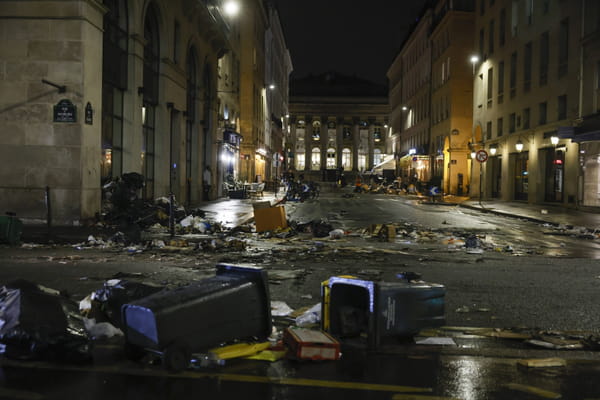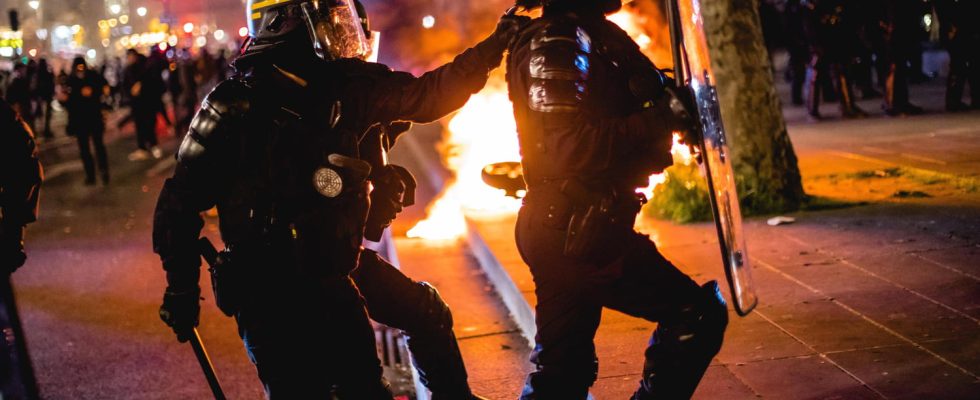The March 23 protests were well attended with 1 to 3.5 million people on the streets, but were marked by an outbreak of violence. Many clashes broke out causing damage in Paris, Bordeaux, Nantes and elsewhere.
- New day of demonstrations this Thursday, March 23 in France, more than 300 rallies were organized in France.
- Between 1.08 and 3.5 million people demonstrated against the pension reform on March 23, according to respective figures from the Ministry of the Interior and the unions. The mobilization of this Thursday is one of the most followed since the beginning of the social movement.
- The mobilization reached a record in Paris with 119,000 demonstrators according to the authorities. While all of them marched peacefully, the demonstration was marked by violent clashes between the 1,500 thugs and black blocks and the police.
- The violence seen in several demonstrations on March 23, in particular in Rouen – where a woman had her thumb torn off by a disencirclement grenade – or in Lyon are unprecedented since the start of the social movement against pension reform.
- After the union demonstrations, wild mobilizations are expected this evening in several cities in France such as Marseille, Lyon, Rouen and probably Paris.
- The inter-union called Thursday evening for a new mobilization on Tuesday March 28, 2023.
Map of March 23 protests
The demonstrations of Thursday March 23 organized at the call of the inter-union are becoming clearer and more than 300 rallies are planned by theUnsa.
Live
12:38 – Anti-Macron, anti-capitalist and anti-police slogans on the walls
In addition to the broken bus shelters, kiosks and windows and the remains of barricades made up of street furniture, the scars of the demonstrations and the violence of the clashes can also be read on the walls and the few windows still standing. Anti-capitalist and anti-Macron slogans are inscribed in various places where demonstrators and thugs have passed. We can also see anti-police messages with “ACAB” (“All cops are bastards” translated by “All the police are bastards”) tagged in the streets.
11:59 – Blockades maintained in front of certain schools
The day after the day of demonstrations, 38 incidents were noted this Friday in front of schools according to the Ministry of National Education. Le Parisien specifies that twelve establishments have been blocked, twelve are the subject of filtering blockages and ten of blocking attempts. The last four establishments were affected by various disturbances: rallies, distribution of leaflets, etc.
11:04 – Streets strewn with trash in the aftermath of the protests

In Paris and elsewhere such as Bordeaux or Rennes and Rouen, the streets were invaded by overturned trash cans and other street furniture that served as barricades for radical demonstrators. If in some places the clearing began this morning, in others the traces of the clashes are still visible.
10:45 – In Nantes, the administrative court attacked and closed
The administrative court of Nantes is one of the places that were targeted by black blocks during the demonstrations of March 23. The vandals entered the premises causing a lot of damage in their path, so much so that the day after the strike the court was still closed.
10:28 – Bus shelters, kiosks, trash cans vandalized in Paris
This morning, in Paris, the traces of the demonstrations on March 23 are still visible. On the sidelines of the clashes between black blocks and forces of the other, acts of vandalism have been carried out by radical individuals: the windows of broken bus shelters, cobbled newspaper kiosks or even the many garbage cans – which are piled up in the streets for about ten days – burned and gathered in barricades.
10:18 – The town hall of Bordeaux set on fire after the demonstrations
The March 23 protests escalated last night in several major cities. One of the strong images of this rise in violence is the door of the town hall of Bordeaux taken by the flames. On RTL this morning, the mayor of the Gironde prefecture Pierre Hurmic “condemned with the greatest virulence such acts of violence”. “I find it hard to understand the point of such acts of vandalism,” he added.
What are the start times and locations for events in Paris and France?
- Paris : at 2 p.m. from Bastille
- Marseilles : at 10:30 a.m. from the Old Port
- Lyons : at 11 a.m. from the Manufacture des Tabacs
- Toulouse: at 3 p.m. at the Saint-Cyprien metro station
- Nice: at 10 a.m. in front of the CADAM, at the Alpes-Maritimes Prefecture
- Nantes: at 10:30 a.m. from the Water Mirror
- Montpellier: at 10:30 a.m. from Place Zeus
- Strasbourg: at 2 p.m. from Avenue de la Liberté
- Bordeaux: at 12 noon from Allées de Tourny
- Lille: at 2:30 p.m. from Porte de Paris
- Rennes: at 11 a.m. from Place de Bretagne
- Toulon: at 10 a.m. from Place de Liberté
- Le Havre: at 10 a.m. from Cercle Franklin
- Dijon: at 2 p.m. from Place de la Liberation
- Nîmes: at 2:30 p.m. from the Jardins de la Fontaine
- Clermont-Ferrand: at 10 a.m. from Place du 1er Mai
- Tours: at 2 p.m. from Place Anatole France
- Perpignan: at 10:30 a.m. from Place de Catalunya
- Rouen: at 10 a.m. from Cours Clémenceau
- Caen: at 2:30 p.m. from the Cargö
What is the route of the demonstration in Paris?
This Thursday, March 23, the demonstration organized in Paris must follow one of the traditional routes of the capital. Starting from the Place de la Bastille, the route includes a passage through the Place de la République, then through the boulevards Saint-Martin, Saint-Denis, Bonne Nouvelle, Poissonnière, Montmartre, des Italiens and finally Capucines. The arrival and dispersal of demonstrators must take place at the Place de l’Opéra.
What route for the event in Marseille?
It is most often from the Old Port that the demonstrations start in Marseille towards the Porte d’Aix. The route must go through the Mucem and the Place de la Joliette.
What is the route of the event in Lyon?
In Lyon, the demonstration of March 23 must leave as usual from the Manufacture des Tabacs to join the Place Bellecour, the place where the demonstrations organized during the week most often end. The path must pass through Saxe-Gambetta and Guillotière, take the eponymous bridge and go to Place Antonin-Poncet.
Dreaded violence at the demonstrations of March 23?
Will the March 23 protests end in clashes between protesters and the police? It is a fear justified by the images of spontaneous mobilizations which have multiplied in recent days. Photos and videos show charges by the authorities, in particular the motorized violent action repression brigade (BRAV-M) in Paris, and violent beatings of demonstrators. “The police intervene in a way… ‘energetic’, let’s say, and sometimes without discernment”, admitted Philippe Martinez in an interview with the World on the eve of the ninth day of mobilization. Accusations of police violence have flared up on the side of left-wing elected officials who have denounced “abusive” interventions and arrests.
These muscular interventions would not however be expected in the processions of March 23, which will be organized and will follow routes determined and marked out by the authorities. According to the explanations of Johann Cavalero, national delegate of the Alliance union, guest on BFM TV, the violence and repression of the police would be a response to unexpected and unpredictable mobilizations: “The difference is that we have no interlocutors to prepare the course or to tell us what they want to do. So we adjust the device and we react to what is happening opposite.” In the eyes of the boss of the CGT, the more numerous and more violent interventions of the police are also an “old tactic” of the government which wants to “inflame things” “to discredit the movement, impress people, scare them and try to regain control of public opinion”.

